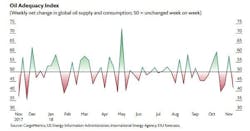The global oil market tightened slightly in the week ending Nov. 23, according to the Oil Adequacy Index, a new measure of oil-market supply created by the Economist Intelligence Unit (EIU) and CargoMetrics.
The index harnesses real-time intelligence on oil production from the Organization of Petroleum Exporting Countries, Russia, and the US, and sets this against the EIU's forecast for global oil consumption, providing an early indicator of the adequacy of global oil supplies.
In the week ending Nov. 23, seaborne crude oil exports from OPEC countries, tracked daily by CargoMetrics, saw a relatively broad decline, with nine of the 15 OPEC member countries registering a week-on-week drop in oil tanker loadings. This followed a notable rise in export levels the previous week, and therefore reflects a normal variation for many OPEC states.
In Saudi Arabia, however, seaborne crude oil exports dropped to one of the lowest weekly levels seen thus far in 2018. Although export volumes will continue to vary from week to week, this may be an early sign that Saudi Arabia is willing to rein in its production in the coming months to support prices.
“The Dec. 6 OPEC and Russia meeting will be critical in this regard, as producers discuss further output cuts in 2019. The reimposition of US sanctions on Iran has created volatility in Iran’s oil sector, and therefore the broader oil market. Although the US awarded last-minute sanctions waivers to major importers of Iranian oil, Iran began underreporting its official export levels in mid-September, in an effort to evade sanctions. Iran’s oil exports have fallen by a substantial margin in October-November compared with the start of 2018, but according to CargoMetrics’ comprehensive data collection, its real export levels are much higher than officially broadcast totals. This should help to keep a lid on prices in the near term. However, policy volatility under the Trump administration means that the sanctions threat could reemerge at any time, so some buyers of Iranian oil will remain hesitant,” the EIU said.
Meanwhile, the global economy is set to cool in 2019-20, as rising interest rates and inflation begin to limit consumption in major developed economies, and the US-China trade war starts to toll on those economies.
Cailin Birch, EIU’s global economist, said, “We expect oil demand growth to slow in the coming months compared with 2017-18, as the global economic cycle starts to turn. The level of oil supplies from Russia, where oil companies are launching new fields after a 2-year freeze, and Iran, where real export volumes are difficult to assess, will therefore have a major impact on prices.”


